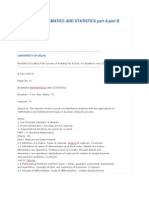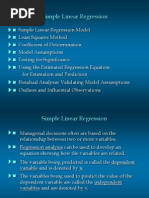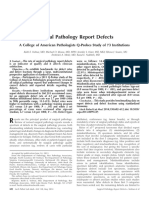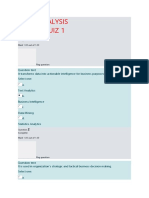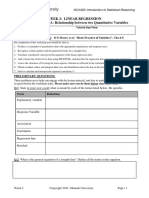Tutorial 4 Assignment 2
Uploaded by
Livingston W.Tutorial 4 Assignment 2
Uploaded by
Livingston W.Assignment 2
Note: Please save all your code in a single do-file with your matriculation number, last name and assignment
number (e.g. 12345_mustermann_assignment2.do) and send it to edona.selimaj@wiwi.uni-muenster.de be-
fore 07/11/24 9:00 am. Make sure that you answer each specific question using comments in your do-file.
(Sub-)Tasks should be separated by comments as well. Only exercises 1-3 have to be handed in, although
you should also prepare exercise 4.
1. The dataset EL_1_Tut4_Ex1.dta contains information on US companies’ earnings per share (eps) and
the respective dividends per share (div). Your task is to analyze the relationship between the two vari-
ables.
a. How many observations contain earnings per share that are equal to or smaller than zero? Use the
count if command. Also make sure that there are only positive dividend payments in the data.
b. Check if the variable div is normally distributed. Compare the density function of the variable with
the density function of the normal distribution. Check your assessment with a formal test and interpret
the results.
c. Estimate the regression model div = β1 + β2∙eps + e and briefly comment on the sign and the signif-
icance of the explanatory variable. What is R² for this regression? What does this value tell you in
this example?
d. Generate the variable ln_div which takes the natural logarithm of the variable div. Explain why you
cannot apply the logarithm to the variable eps.
e. Estimate the regression model ln(div) = β1 + β2∙eps + e and interpret the coefficient β2. Compare this
model’s performance to the one from subtask c).
2. What is a fitting prediction model for a volatile share? In dataset EL1_SA2_Ex2.dta you can find a 48
months-time series with share prices of an oil and gas conglomerate OILLUK. The share prices are
taken from the first trading day each month from the respective stock exchange. Consider the following
equations for your analysis:
(1) oillukt = β1 + β2 time+ et
(2) oillukt = 1 + 2 ln(time)+ et
(3) oillukt = 1 + 2 time2+ et
Empirical Lab WS 2024/2025 – Assignment 2: Linear Regressions –1–
a. Generate the transformed variables and estimate the regression equations above. Briefly comment on
your results.
b. After estimating each equation above, generate a new variable containing the prediction of the de-
pendent variable (ŷ). Use the predict newvar, xb (variable name usually contains yhat for ŷ)
command. Also generate the estimated residuals (ê) with the predict newvar, residuals
(variable name usually contains ehat for ê) command.
c. In your opinion, which of the three models fits best to the share price data of OILLUK? For your
reasoning, make use of (i) graphs of the estimated equation, (ii) residual plots, (iii) tests for normal
distribution of residuals and (iv) values of R2.
Possible command for (i): line oilluk time || line yhat_varname time
Possible command for (ii): rvpplot indepvar, yline(0)
d. For each model, calculate the estimated OILLUK price for month time=49. Use the display com-
mand and state your calculation method.
e. Calculate the estimations of the slope yt/dt for time=49. Comment on the results. In addition, discuss
the change of interpretation of the coefficients before and after the explanatory variable was trans-
formed.
3. The goal is to empirically assess the relationship between market capitalization of a company (share
price multiplied with number of shares) and its beta value. You have a data set of the NYSE Alternext
market available. NYSE Alternext is a market for young companies in Europe. In the data set
EL1_SA2_Ex3.dta you can find cross-sectional data with 712 observations. Variables consist of
datastream code (ds_code), beta value (beta), market capitalization in USD million (market_value) as
well as the industry of each company (industry).
a. Check first if there are missing values and delete observations that have missing values for beta. Then
make sure that market_value does not contain any faulty values and there are no negative values for
beta and market_value in the data set. How many observations remain in the data set?
b. Look at the mean, standard deviation, median and quartiles of beta and market_value. What do you
notice? What can you conclude for the density function?
c. Estimate the linear regression beta = β1 + β2 market_value + e. Discuss the economic significance
of the coefficients. Rescale variables to improve the economic significance as appropriate. Estimate
the regression again in this case and interpret the results (e.g., value and statistical significance of the
coefficient according to a 5%-level, R2).
Empirical Lab WS 2024/2025 – Assignment 2: Linear Regressions –2–
d. Estimate the regression again for the subsample industries (i) Financials and (ii) Basic Materials. Use
the command regress depvar indepvar if. Do you notice differences to the regression in
c)? Discuss your results using the same criteria as above.
4. In financial economics, the Capital Asset Pricing Model (CAPM) explains the fluctuations of the return
of a share dependent on the return of the market portfolio. Generally, the return of an asset is measured
relatively to the opportunity costs of investing in a risk-free asset. The difference between the return of
a risky asset and a risk-free asset is called risk premium. According to the CAPM, the risk premium of
an asset j is proportional to the risk premium of the market portfolio:
𝑟𝑗 − 𝑟𝑓 = 𝛽𝑗 ∙ (𝑟𝑚 − 𝑟𝑓 ).
rj is the return of the asset, rf is the risk-free rate, rm is the return of the market portfolio and βj is the
beta-value of j. Beta measures the sensitivity of the asset return to fluctuations in the whole market. A
beta smaller than 1 indicates that the asset fluctuates less than the market (“defensive share“). A beta
greater than 1 indicates an “aggressive” share, as it fluctuates more strongly than the market. The econ-
ometric equivalent of the above model is obtained by adding the intercept and the error term:
𝑟𝑗 − 𝑟𝑓 = 𝛼𝑗 + 𝛽𝑗 ∙ (𝑟𝑚 − 𝑟𝑓 ) + 𝑒.
a. Explain why the above econometric model is a simple linear regression model. Argue based on the
formula for a linear relationship discussed in the lecture.
b. In the dataset EL_1_Tut4_Ex4.dta you can find monthly returns of shares of six companies. Addi-
tionally, you can find the variable mkt with the monthly market returns as well as the risk-free rate rf.
The 141 observations cover the period from January 2009 to September 2020. Estimate the CAPM
for every company and comment on the estimated beta-values. Which shares are aggressive, which
are defensive?
c. Theory says that the axis intercept αj is 0. Does this coincide with your estimations? Generate a scat-
terplot with the estimated regression line and see if the regression line runs through the origin. Inter-
pret the p-values of the intercepts according to a two-tailed hypothesis test at a 5% level.
d. Estimate the model for every company under the assumption αj = 0. Use the command regress
depvar indepvar, noconstant. Do the beta-values change? How does this estimation in-
fluence your categorization as aggressive/defensive?
Empirical Lab WS 2024/2025 – Assignment 2: Linear Regressions –3–
You might also like
- Predicting Airline Passengers Satisfaction100% (7)Predicting Airline Passengers Satisfaction70 pages
- Advanced C++ Interview Questions You'll Most Likely Be AskedFrom EverandAdvanced C++ Interview Questions You'll Most Likely Be AskedNo ratings yet
- MSC Econometrics (Ec402) : 2021-2022 Problem Set #3No ratings yetMSC Econometrics (Ec402) : 2021-2022 Problem Set #33 pages
- Linear Regression Model: Man - PN@VNP - Edu.vnNo ratings yetLinear Regression Model: Man - PN@VNP - Edu.vn77 pages
- Exercise EC5002 Econometrics All QuestionsNo ratings yetExercise EC5002 Econometrics All Questions24 pages
- Shanghai Jiaotong University Shanghai Advanced Institution of FinanceNo ratings yetShanghai Jiaotong University Shanghai Advanced Institution of Finance3 pages
- Stat 331 Applied Linear Models - Assignment 1: I 0 1 I I I I N I 1 2 INo ratings yetStat 331 Applied Linear Models - Assignment 1: I 0 1 I I I I N I 1 2 I2 pages
- Residual Analysis For Simple Linear Regression: X B B y N e N eNo ratings yetResidual Analysis For Simple Linear Regression: X B B y N e N e15 pages
- 15.433 INVESTMENTS Class 7: The CAPM and APT Part 2: Applications and TestsNo ratings yet15.433 INVESTMENTS Class 7: The CAPM and APT Part 2: Applications and Tests25 pages
- M2L2 CLRM & Simple Linear Regression AnalysisNo ratings yetM2L2 CLRM & Simple Linear Regression Analysis13 pages
- ECE 3040 Lecture 18: Curve Fitting by Least-Squares-Error RegressionNo ratings yetECE 3040 Lecture 18: Curve Fitting by Least-Squares-Error Regression38 pages
- Econometrics - Exercise set 2 (solution)No ratings yetEconometrics - Exercise set 2 (solution)12 pages
- Tutorial 1-13 Answer Intermediate MacroNo ratings yetTutorial 1-13 Answer Intermediate Macro40 pages
- Robust Regression Modeling With STATA Lecture NotesNo ratings yetRobust Regression Modeling With STATA Lecture Notes93 pages
- Group 1 ECON6006 Financial Econometrics Assignment 2 SubmissionNo ratings yetGroup 1 ECON6006 Financial Econometrics Assignment 2 Submission20 pages
- Multiple Linear Regression Analysis UsinNo ratings yetMultiple Linear Regression Analysis Usin19 pages
- Time Series Econometrics TSE48M1 Assignment: Due 25 June 2021 100 MARKSNo ratings yetTime Series Econometrics TSE48M1 Assignment: Due 25 June 2021 100 MARKS3 pages
- SVKM'S Nmims Anil Surendra Modi School of Commerce Academic Year: 2020-2021No ratings yetSVKM'S Nmims Anil Surendra Modi School of Commerce Academic Year: 2020-20213 pages
- This Study Resource Was: Name: Course: Econometrics Student Id: Program: Mba (R)No ratings yetThis Study Resource Was: Name: Course: Econometrics Student Id: Program: Mba (R)6 pages
- Solutions Manual to Accompany Introduction to Quantitative Methods in Business: with Applications Using Microsoft Office ExcelFrom EverandSolutions Manual to Accompany Introduction to Quantitative Methods in Business: with Applications Using Microsoft Office ExcelNo ratings yet
- ECO401-Econometrics: Panel Data-Estimation Using StataNo ratings yetECO401-Econometrics: Panel Data-Estimation Using Stata9 pages
- Quality Prediction in Object Oriented System by Using ANN: A Brief SurveyNo ratings yetQuality Prediction in Object Oriented System by Using ANN: A Brief Survey6 pages
- Mcerlain-Naylor2014 - Determinants of Countermovement Jump Performance A Kinetic and Kinematic AnalysisNo ratings yetMcerlain-Naylor2014 - Determinants of Countermovement Jump Performance A Kinetic and Kinematic Analysis9 pages
- Full download (Ebook) The Work-Family Balance in Light of Globalization and Technology by Mireia Las Heras; Nuria Chinchilla; Marc Grau ISBN 9781527502826, 1527502821 pdf docx100% (4)Full download (Ebook) The Work-Family Balance in Light of Globalization and Technology by Mireia Las Heras; Nuria Chinchilla; Marc Grau ISBN 9781527502826, 1527502821 pdf docx71 pages
- Step 1: Generate/Run The Results For The Fixed Effects RegressionNo ratings yetStep 1: Generate/Run The Results For The Fixed Effects Regression4 pages
- KATZ JUNG CALLORDA - The role of Video on Demand in stimulating broadband adoptionNo ratings yetKATZ JUNG CALLORDA - The role of Video on Demand in stimulating broadband adoption23 pages
- Contemporary Statistical Models for the Plant and Soil Sciences 1st Edition Oliver Schabenberger Francis J. Pierce - The complete ebook version is now available for downloadNo ratings yetContemporary Statistical Models for the Plant and Soil Sciences 1st Edition Oliver Schabenberger Francis J. Pierce - The complete ebook version is now available for download53 pages
- Lecture 2 Additional Notes Introduction To Statistical ModellingNo ratings yetLecture 2 Additional Notes Introduction To Statistical Modelling2 pages
- 100-Machine-Learning-Interview-Questions-and-Answers (Downloaded From Internet)No ratings yet100-Machine-Learning-Interview-Questions-and-Answers (Downloaded From Internet)24 pages
- B.Sc. (H) Probability and Statistics 2011-2012No ratings yetB.Sc. (H) Probability and Statistics 2011-20122 pages
- Beyond Description: An Integrative Model of Content AnalysisNo ratings yetBeyond Description: An Integrative Model of Content Analysis15 pages



